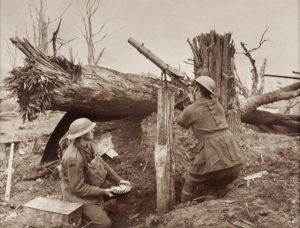Monday March 11th, 1918
Reveille 6:30, breakfast 7am. Anti-malaria medicine 7:45. Parade 8am. Drill Lewis Gun & tactics. Dodged fatigues. Afternoon wrote home. Nice day, plenty of sun, very warm.
Lewis Guns
Today Frank is being instructed on the Lewis Gun and its tactics. When he had proved to be a good shot during his Army training at Filey in 1917, Frank had been sent for additional training on the Lewis Gun. While it doesn’t appear that Frank was ever part of a machine gun crew, it was clearly a weapon with which he was familiar.
The Lewis Gun was invented by Colonel Isaac Newton Lewis of the US Army in 1911. Unfortunately the US Army wasn’t that keen on the new machine gun, but the Belgians were. Therefore Lewis resigned his commission and opened a factory in Liege in 1913. He also secured a licensing deal with BSA in the UK. The threat of war caused Lewis to dismantle the Belgian factory and relocate to the UK in 1914.

However, when war broke out the Belgian army had a few Lewis guns in operation whilst the British Army had two Vickers machine guns allocated per Battalion. By October 1915, the British Army had adopted the Lewis Gun and early the following year it was in widespread use on the Western Front and elsewhere. By the end of the War over 50,000 of them had been produced in the UK and US.
The version manufactured by the BSA used the British standard .303 calibre bullets (as per the Lee-Enfield rifle). The Lewis Gun had a circular cartridge with either 47 or 97 bullets, it could fire 500 to 600 rounds per minute (though was more often used in short bursts) and had an effective range of about 600 metres. The Lewis Gun was over 60% more expensive than its Vickers’ equivalent despite only taking one sixth of the time to manufacture and being half its weight (coming in at 28 lbs / 12.7 kgs). This photograph shows two British soldiers with a Lewis Gun, one aiming the gun and the other holding a loaded circular cartridge.
Machine Gun Tactics
Its mobility and reliability meant it was popular with the Infantry units as well as the Navy, the Marines and the air forces. With modified bullets, it was also used to attack Zeppelins, other airships and balloons. The Vickers was retained for the less mobile Machine Gun batteries.
The tactics for the deployment of machine guns also evolved over the course of the war. Initially the strategy had been for a mobile offence, using the machine guns on the flanks and sparingly until additional firepower was needed to clear well-defended positions. Obviously this changed as the armies on both sides, and on many fronts, became bogged down. There was also considerable debate about whether machine guns should be spread across the infantry line or used primarily by special units. At the outbreak of war the British favoured the former and the Germans the latter.
In 1914 each infantry battalion had two machine guns and in 1915, they had four. By 1917, each Battalion had 36 with a further 64 held centrally in the Divisional machine gun battalion. So by the end of the war, the debate about concentrated or devolved use ended: the British had decided to have both.
13th (Service) Battalion War Diary – 11th March 1918 – No 1 Sector, Olasli
Training as per programme. 1 OR struck off effective strength under GRO 1011 on 3-3-18 (on being taken on effective strength of 66th Brigade) 4 OR from 9-3-18 and 3 OR from 10-3-18. 2 OR rejoined 28-2-18, 2 OR on 3-3-18, 1 OR on 8-3-18 and 1 OR on 9-3-18.
References & Further Reading
‘Lewis Gun‘ on Wikipedia
‘Lewis Gun‘ on Spartacus
* image may be subject to copyright


